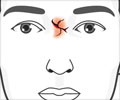
Bourke drew from a branch of engineering called computational fluid dynamics, an approach commonly used in the aerospace industry and medicine, to model how air flowed through the noses of modern-day dinosaur relatives such as ostriches and alligators. Among dinosaurs the best fit for the study were the pachycephalosaurs, or "pachys," a group of plant-eating dinosaurs best known for the several-inch-thick bone on the tops of their skulls which was thought to have served both as a visual display and as protection for head-butting behaviors like those of modern-day rams.
Emma Schachner, from Louisiana State University, said that when they cleaned up the fossil skull of Sphaerotholus, a pachy from North Dakota, they didn't expect to see these delicate scrolls of bone in the nasal region and they knew it must be nasal turbinates.
The first nasal turbinates to be discovered were in the back part of the nasal cavity, called the olfactory chamber, where smelling takes place. Work by Lawrence Witmer and Ohio University researcher Ryan Ridgely on CT scans of Stegoceras showed that the olfactory region of the brain was quite large, which, along with the large olfactory turbinates, suggested that Stegoceras had a good sense of smell.
Some scientists had previously suggested that warm-blooded animals such as birds and mammals have turbinates to act like condensers to save water that might have been lost during exhalation. That might be true in some cases, but this new research suggested that turbinates also have important functions as baffles to direct air to the olfactory region. But they might also play another critical role, cooling the brain.
Ruger Porter Ohio University doctoral student, who has been studying the pattern of blood flow in pachycephalosaurs and other dinosaurs, as well as their modern-day relatives, said that the fossil evidence suggested that Stegoceras was basically similar to an ostrich or an alligator and hot arterial blood from the body was cooled as it passed over the respiratory turbinates, and then that cooled venous blood returned to the brain.
Advertisement







